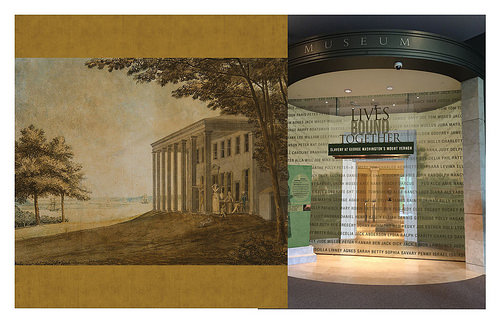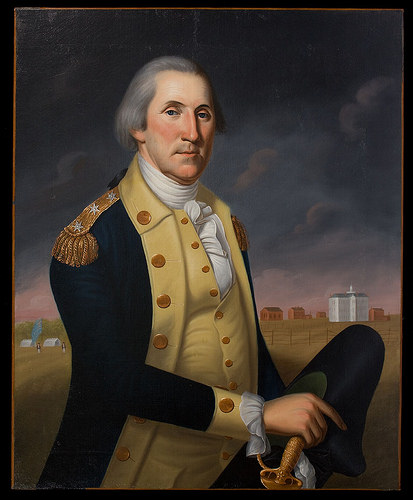
MOUNT VERNON, VA – George Washington’s Mount Vernon is taking a significant step to share new knowledge about the lives of the enslaved people who lived and worked at the estate during Washington’s time by mounting a ground-breaking new exhibition. Opening October 1, 2016, Lives Bound Together: Slavery at George Washington’s Mount Vernon explores the personal stories of these men and women while providing insight into George Washington’s evolving opposition to slavery.
Through household furnishings, art works, archaeological discoveries, documents, and interactive displays, the exhibition, which will span 4,400 square feet throughout all seven galleries of the Donald W. Reynolds Museum, demonstrates how closely intertwined the lives of the Washingtons were with those of the enslaved. Nineteen enslaved individuals are featured throughout the exhibit, represented with life-sized silhouettes and interactive touchscreens providing biographical details.
“Mount Vernon is the best documented estate of its kind because George Washington was a meticulous record keeper,” said Mount Vernon president Curt Viebranz. “As he made notes about activities at his home and on his farm, he was, in a way, writing biographies for these men and women who left no written records behind.”
“Slavery has been an important focus of our research and interpretation for more than 150 years. What is new is that we now have the will and the way to bring to life the stories of specific individuals, so that they are forgotten no more,” said Viebranz.
__________________________________________
 Above: The new exhibit will open October 1, 2016 at George Washington’s Mount Vernon. Image courtesy George Washington’s Mount Vernon
Above: The new exhibit will open October 1, 2016 at George Washington’s Mount Vernon. Image courtesy George Washington’s Mount Vernon
To prepare for this exhibition, which was developed over the course of two years at a cost of $750,000, the Donald W. Reynolds Museum, which opened to visitors in 2006, will undergo extensive updating. When the museum reopens with the exhibition installed, guests will see how the enslaved people played a role in nearly every aspect of daily life at Mount Vernon. More than 150 artifacts will be on view—seeds and animal bones, ceramic fragments and metal buttons unearthed from archaeological excavations around the estate, as well as fine tablewares and furniture from the Washington household, providing insights into the enslaved community’s daily lives and work.
Through the exhibition, guests will gain a better understanding of Washington’s changing views toward slavery, culminating in his landmark decision to include in his will a provision freeing the slaves that he owned. Washington’s writings reveal how he grappled with the issue of slavery over the course of his life. As a boy, he had inherited 10 slaves, and as an adult he purchased additional slaves to maintain and operate his home, as well as the thousands of acres of land that generated cash crops. During and after the Revolution, his opinion of slavery began to change and he struggled to extricate himself from reliance on slave labor.
During the first five months of Lives Bound Together, visitors will have an opportunity to view original manuscript pages from George Washington’s will, written in July 1799, showing his decision to free the slaves he owned. This bold act came with heart-wrenching side effects: slaves owned by the estate of Martha Washington’s first husband could not be freed by Washington. Granting these men and women freedom also tore apart families.
Although the development of this exhibition is a significant step in Mount Vernon’s ongoing effort to tell authentic stories of George Washington and his life and times, slavery interpretation has long been an important focus for research. Given George Washington’s extraordinary record keeping, Mount Vernon is arguably the best-documented plantation in eighteenth-century America. Currently Mount Vernon interprets slavery as part of its guided mansion tours, at its slave quarters, reconstructed slave cabin, slave memorial, and through a regularly-scheduled walking tour. Slavery is also the focus of the J. Hap and Geren Fauth Gallery in the Donald W. Reynolds Education Center.
Source: Press release of George Washington’s Mount Vernon by Melissa Wood, Director of Media Relations
____________________________________________________
The Lives Bound Together exhibition could not have been made possible without the contributions from individuals and foundations in addition to three special donors: Ambassador and Mrs. Nicholas F. Taubman, Dr. Scholl Foundation, and The Coca-Cola Company. To prepare for the opening of this significant exhibition, the Donald W. Reynolds Museum will be closed beginning May 31 while its permanent galleries undergo a complete transformation. The exhibition will remain on view for at least two years. For more information, please visit: www.mountvernon.org/slavery.
____________________________________________________

______________________________________________
Travel and learn with Far Horizons.
____________________________________________
This richly illustrated issue includes the following stories: Recent findings shedding new light on the whereabouts of the remains of Philip of Macedon, father of Alexander the Great; how an archaeologist-sculptor is bringing bones of the dead back to life; archaeologists uncovering town life at the dawn of civilization; an exclusive interview with internationally acclaimed archaeologist James M. Adovasio about what makes the Meadowcroft Rockshelter prominent in the ongoing search for the first Americans; what archaeologists are finding at the site of the ancient city of Gath, the home town of the biblical Philistine giant, Goliath; and how scientists are redrawing the picture of human evolution in Europe. Find it on Amazon.com.









